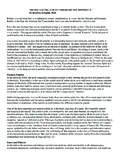Transcription of Undergraduate Organic Synthesis Guide - Paul …
1 1 Paul Bracher Chem 30 Synthesis Review Guide to Solving Sophomore Organic Synthesis Problems Disclaimer Omission of a topic on this handout does not preclude that material from appearing on the final exam. Any material that we have covered in lecture, in a problem set, or in the book is fair game. The exam is cumulative and may include information from previous exams and Chem 20. I have not seen the exam and the concepts discussed here are my personal choices for what I believe to be especially pertinent to Synthesis on the exam. Have a nice day. Undergraduate Organic Synthesis vs. Real Organic Synthesis The Synthesis problems you encounter in Undergraduate Organic chemistry are usually different from those tackled by academic research groups. First of all, Chem 30 problems are designed to test your knowledge of the course material. As you wind through the semester, you pick up new reactions which may be placed in your synthetic toolbox. While a modern chemist is free to choose from all sorts of reactions, you are limited to those presented in the course.
2 Furthermore, while a practicing Organic chemist is only limited by what is commercially available, in Undergraduate Synthesis problems, you are often restricted to using specific starting materials or reagents. The take-home message is not to associate exam problems too closely with what chemists actually do. Nevertheless, it is important to learn basic Organic reactions and the skills you learn are still very applicable to real Organic Synthesis . Managing your Synthetic Toolbox Your synthetic toolbox encompasses all of the material you ve learned that is useful in constructing Organic compounds. These can be single reactions that transform one functional group into another, a sequence of reactions used to construct a more complex functionality, or general techniques and methods that are universally applicable. As you come across a new reaction or technique, you should keep track of it in your notes. One of the best ways to do this is by making index cards. While there are a couple of sets of pre-made Organic chemistry cards available in bookstores, they are a poor substitute for making your own.
3 Look for reactions in: Problem set and exam Synthesis questions Lecture packets, especially the reactions that are discussed in detail or given their own section Loudon and other Undergraduate textbooks General Advice on How to Study Do practice problems. Start with problems from the book (they are easier) then move on to problems associated with the course (do the practice exam, redo the problem sets, do the section practice problems, do the problems in the lecture notes, do the problems on the database). Focus on the interconnectivity of functional groups know how to get from one group to another in both directions. Make cheat sheets that detail the reactions and transforms (how to make particular structural motifs). Please refrain from actually using the cheat sheet to cheat on an exam. 2 General Approaches to Synthesis Problems Basic Synthetic Strategies 1) See if the synthons you are given suggest an obvious forward step 2) Try mapping the synthons on to portions of the target.
4 If you can figure out where a synthon fits into the puzzle, you can then worry about properly arranging reactions to establish the connectivity. 3) If these methods don t work, take your target molecule and break it apart by going backwards one reaction at a time. With each step back, see if it is now more obvious how to work forward from the starting materials. Try to put the most complicated steps towards the end of your Synthesis . 1) Trained Response / Reflex In some cases, it is not hard to look at a target and immediately see the key functional transformations. You ll find that this easy approach will occur more frequently as you do practice problems and study your synthetic transforms. Target PhSPhO Transforms PhSPhterminal olefin transform: Wittig Olefinationformercarbonyl -functionalized carbonyl transform:Conjugate Additionformer , -unsaturated ketone , -unsaturated ketone transform: Aldol Condensation1452354 Conversion O+OPhHNaOHOPhPhCH2 SHpyridinePhSPhPh3 PCH2 OPhSPh 3 2) Atom Mapping The Forward Approach Target EtOOEtOOOOand anything else with four or fewer carbons Approach Whenever you are told to begin with a specific starting material, you will have to find, or map, this compound into the product by matching atoms or functional groups.
5 Malonic ester syntheses are particularly difficult, because you will usually decarboxylate somewhere down the line, which makes mapping harder since some atoms disappear. A common approach is to add a COOR group to the -carbonyl position in the product, which is essentially a retrosynthetic decarboxylation. After this, you can loosely apply your transforms and then write out your answer with all of the synthetic details. OOOOCOOEtOEtOOOEtAdd COOEt group to -carbonyl positionnow you can mapin the malonic ester12 -alkylated ketone transform: Michael Addition to , -unsaturated carbonyl41,3-dicarbonyl transform: Claisen Condensation3 OEtOOOEtO+Selective 1,2-additionTransform: Alkyllithium addition5 4 Conversion EtOOEtOONaHOH1) nBuLi2) H3O+OHnBuDMPOnBuOEtOOCCOOEtEtOHOOCOOEtNa OEtOO1) NaOH2) H3O+3) excess 5 3) Retrosynthetic Analysis The Backward Approach Target OHHONMe2 ONMe2 OOOand any other necessaryreagents Approach The product and starting material are giveaways for a Diels-Alder reaction somewhere in the Synthesis .
6 However, we must work backwards to get to this point. When you are initially working through the problem, don t waste time writing every specific detail in case the path becomes a dead end. Jump backwards as many moves as you can keep straight in your head. OOOOOOTBSOOONMe2 NMe2 OOHHONMe2 ONMe2alcohol transform: carbonyl reduction1amides originate from anhydride opening and DCC-activated amide formation2 Ketone from enol tautomerization gives obvious Diels-Alder retrosynthon:3obvious Diels-Alder adduct4O154326 Conversion OOOTBSO+ OOTBSOOMe2 NHONMe2 ONMe2 TBSOKFONMe2 ONMe2 ONaBH4 OHHONMe2 ONMe2H2OH2O2 In reality, the method that you end up using will be a combination of the three. Since usually you are given starting materials that you must use, it is impossible to work entirely backwards chances are won t arrive at the given starting material. Instead, it makes sense to work backwards, then forwards, then repeat this process until your chemical intuition sparks so that you can join the backwards and forward routes by Synthetic Peccadilloes to Avoid 1) When applicable, include all necessary reagents OOHOOHH3O+OOHOOHH2 OOOHOOHH+BadBadGood 2) Pay attention to sequential addition of reagents O1) H3 CMgBr2) H3O+OHOH3 CMgBrH3O+OHGoodBad Also, ozonolysis is 1) O3, 2) DMS or H2O2/NaOH 3) Double-check your Carbon Counting OHOONaOHH2 OnotOHO 4) Use the Functional Groups of your Starting Material in Order of Decreasing Reactivity There are probably plenty of exceptions to this generalization, but when given a choice, you want to use the most reactive functionality first to minimize the possibility of deleterious side reactions OONOOEtNH2H2, Pd/COONOOONHH2, Pd/CEtNH2 ONHW orse RouteBetter Route 7 5)
7 Protect Reactive Functionality HOBr2CH3 OHTBSClNEt3 TBSOBr2CH3 OHTBSOBrOCH3 OBrnotHOBrOCH3 TBAFpH 7 H2O 6) Be Careful in Deciding Upon the Conditions for Generating Your Enolate OPhHONaOMeMeOHOPhOPhHOOPh1) LDA, 0oC2)3) H3O+OHOPhHOOPh1) LDA, 0 oC2)OPhHO1) LDA, -78 oC2)3) H3O+OPhHO1) LDA, -78 oC2)OOPhOHPhNaOR base is usually fine here, although I prefer the LDA method, especially for crossed ) LDA, 0 oC2) CH3IO1) LDA, -78 oC2) CH3 IODo not use NaOR/ROH to make thermodynamic enolates for alkylation. The enolate generation is an equilibrium and you will end up hydrolyzing the alkyl ) NaH or NaOEt2) CH3 IEtOOOOEtEtOOMalonates are quite acidic, so you needn't worry about equilibria with weak bases and there is no need to use expensive basic reagents. 8 7) It is difficult/impossible to alkylate enolates with 2 and 3 alkyl halides. Find a better way. OPhEtCH3 BrOPh1) LDA2)1) LDA2) CH3 CHO3) H3O+OPhCH3 Bad!1) Et2 CuLi2) H3O+Good 8) Avoid Overalkylating Unless you want an extensively alkylated product ( 4o amine), don t alkylate amines or benzene with alkyl halides.
8 It is very hard to prevent the monoalkylated product from reacting further. 9) Play By the Rules (Read the Question) Don t just dive in by looking at the figure be sure to read the question prompt as well. If a Synthesis problem says to use a certain starting material or to use only compounds with n or fewer carbons, then abide by these rules (or face the wrath of our red pens). Pay attention to detail don t get nickeled and dimed for points!9 Super Double Secret Crack the System Test-Taking Tips 1) Know Your Reactions and Synthetic Transformations There is a list of some common synthetic transformations that we have learned this semester at the end of this packet. There is no excuse for not learning these, aside from stupidity or a desire to flounder on Synthesis problems. You will bomb a fill-in-the-blank Synthesis question if you don t know your reactions cold. This handout is nowhere near exhaustive study the lecture notes too. 2) Look at the Point Value of the Problem In general, more points are assigned to Synthesis problems that have longer routes involving more reactions.
9 If you arrive at a long answer for a problem that has been assigned relatively few points, think twice about your answer. Chances are that you have overlooked a more direct approach to the target. 3) Don t Dig too Deeply From my recollection, I don t recall any extraordinarily long syntheses, either this year or in years past. If you re roaring past ten steps, chances are you d better wrap it up soon or look for another route. 4) Lost? Try Running Through Reactions While this approach is more useful for the midterm exams, if you are lost, try running through the reactions from a particular unit. It is highly unlikely that we would put a Synthesis problem on the final exam in which all of the steps were reactions from Chem 20. 5) Don t Embarrass Yourself This is more of a personal beef. If you are lost and can t bridge two synthetic intermediates, please don t write magic over the reaction arrow. It s a lame excuse, equivalent to writing my brain doesn t work, I didn t study enough, or I am too lazy to think about this.
10 Magic is for television witches and high schoolers who enjoy Dungeons & Dragons. If you plan on screwing up a Synthesis problem, perhaps you can come prepared with witty new material that will amuse the graders. 6) Don t Leave a Synthesis Question Blank It is a sad state of affairs when you leave a Synthesis problem blank (or any problem, for that matter). At the very least, try to make some retrosynthetic cuts and identify key reactions. I always did my Synthesis problems on the exam page, not scratch paper, because if I ran out of time I knew I d have something down. Graders try to give partial credit make it easy for us to justify doing so. A blank response can be given nothing but a zero. 7) Don t Panic If you are stuck, move on to another question instead of wasting time. Some material later on in the exam may inspire you. Don t panic. Besides failing this course and ending your chances of having a successful career, what s the worst that could happen? 10 Common Reduction-Oxidation (Redox) Reagents Oxidants DMP 2 alcohols ketones, 1 alcohols aldehydes (Swern oxidation does the same) CrO3 1 alcohols aldehydes.







